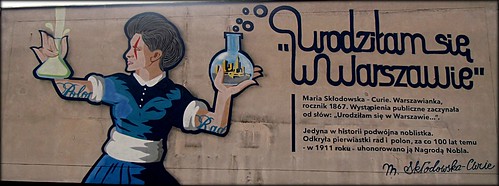Our amazing Maria Skłodowska-Curie!It’s been 100 years! Posted by Kasia on Dec 26, 2013 in Uncategorized
At the end of summer 1911 when Maria Curie was participating the Solvay Conference in Brussels, she received a telegram from Nobel Committee in Sweden. She was awarded the second Nobel Prize, this time in chemistry. She was recognized for producing a sufficient amount of two new elements, polonium and radium, for establishment their atomic weight and other unusual and radioactive properties.
Maria was not only the first Pole and the first woman to receive a Nobel award (the first one in 1903). She was also the first person who received two Nobel awards in two different areas of science.
In spite of the world recognition this was not an easy time for Maria from many reasons. She became a widow after unfortunate accident of Pierre Curie, her husband. Pierre, 49 years old, died under a horse drawn cart. The loss of Pierre was difficult for Maria and her two daughters, small Eve was just 2 years old. Maria eventually recovered from depression which haunted her on and off since the loss of her mother when she was just twelve. The laboratory became her safe heaven. Maria continued Pierre’s lectures at Sorbonne’s university and eventually became the first female, who served as a professor in Sorbonne. She was greatly helped by Eugene, Pierre father, who took care of Irene and Eve.
With the help of Andre Debierne, later discoverer of actinium, she was able to extract weighable amounts of not only radium but polonium in order to be able to determine their properties. It was an arduous work to extract small but measurable mass of radioactive materials – seven tons of pitchblende from Moravia had to be treated.
The Curie’s laboratory was considered superior for extraction and measurements of radioactive properties. Thanks to Maria’s persuasion, during the International Congress of Radiology and Electricity in Brussels in 1910 it was agreed to put forth a standard unit of measuring radioactivity based on the radioactivity obtained from 1 g of Radium and call it “Curie”. Still, Maria was treated with prejudice as a woman. When she announced her candidacy for a Chair of Physics in Academy of Sciences, the most powerful scientific body in France, she was rejected. When in January 1911 the members of Academy of Science gathered to vote, Maria was not even allowed to enter and present her work since she was a woman. In spite of the support of many members she lost.
When Maria returned to France after Solvay Conference in 1911 and after the announcement about second Nobel award she was greeted with public condemnation. It was revealed by venomous press that she had a love affair with Paul Langevin. Langevin was a renowned physicist, the ex-student of Pierre Curie, who was unhappily married and had several extramarital affairs, Maria was neither first nor the last on his list. Langevin’s wife revealed intimate letters of Maria to the press. The French press stood viciously against Maria – a woman and a foreigner. She was accused of being a home wrecker, a dissolute woman and a Polish temptress. Maria became so close to the public disgrace that a member of Nobel Committee wrote to her on behalf of the Committee suggesting her not to accept a Nobel award.
Maria was not a person who was easily detracted. She attended the Nobel ceremony accompanied by her sister Bronya and her older daughter Irene, fourteen years old. Maria’s acceptance speech confirmed her own credentials in the discoveries of polonium and radium. She was congratulated by king Gustaf.
Less than a month after she returned to Paris she was rushed to the hospital. She was diagnosed with kidney disease, but she probably also suffered a total nervous breakdown. Her illnesses were probably a consequence of the hard work, radiation effects and the vicious condemnation campaign after the affair. Although Maria did not believe that she would survive a kidney surgery and she instructed Debierne what to do with her precious radium after her death, she was soon back on her feet and ready for work as usual.
Do następnego razu… (Till next time…)

Build vocabulary, practice pronunciation, and more with Transparent Language Online. Available anytime, anywhere, on any device.
About the Author: Kasia
My name is Kasia Scontsas. I grew near Lublin, Poland and moved to Warsaw to study International Business. I have passion for languages: any languages! Currently I live in New Hampshire. I enjoy skiing, kayaking, biking and paddle boarding. My husband speaks a little Polish, but our daughters are fluent in it! I wanted to make sure that they can communicate with their Polish relatives in our native language. Teaching them Polish since they were born was the best thing I could have given them! I have been writing about learning Polish language and culture for Transparent Language’s Polish Blog since 2010.




